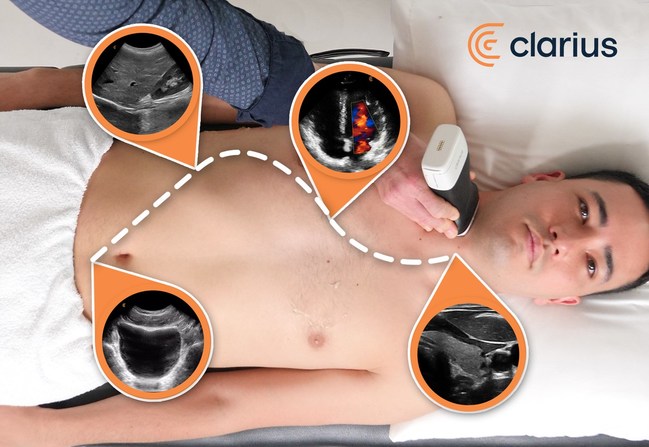Clarius Ultrasound Systems Use AI to Recognize Anatomy
 Clarius Mobile Health has introduced a new feature that allows its wireless ultrasound systems to automatically detect anatomy being scanned by clinicians. This new feature is now available through a Clarius Ultrasound App update on the Clarius C3 HD multipurpose and the Clarius PA HD phased array ultrasound systems.
Clarius Mobile Health has introduced a new feature that allows its wireless ultrasound systems to automatically detect anatomy being scanned by clinicians. This new feature is now available through a Clarius Ultrasound App update on the Clarius C3 HD multipurpose and the Clarius PA HD phased array ultrasound systems.
These high-definition scanners now enable clinicians to quickly examine the abdomen, heart, lungs, bladder, and other superficial structures without additional interaction through the App. Users simply select Auto Preset AI and the Clarius App will automatically adjust settings to optimize imaging for the area being examined.
“Although machine learning and artificial intelligence have been applied to medical imaging over the past several years, this is the first commercially available application that enables an ultrasound system to recognize anatomy on a macro level, allowing the AI to recognize different structures in the human torso," says Kris Dickie, Vice President of Research and Development at Clarius. “We've labelled tens of thousands of ultrasound images within our vast database to achieve this exciting breakthrough, which will help clinicians to get the answers they need more rapidly.”
In addition to Auto Preset AI, Version 8.0 of the Clarius Ultrasound App includes dozens of new features and enhancements, most of which are available across the entire Clarius product line.
Dr. Oron Frenkel, an emergency physician and Chairman of the Clarius Medical Advisory Board, works on ultrasound education and developing features that help clinicians master ultrasound imaging.
“Ultrasound is an amazing tool that gives those of us who know how to use it an instant window into the patient's body," says Dr. Frenkel. “I'm excited about the many features in this Clarius Ultrasound App update that will help enhance ultrasound proficiency. Besides the Auto Preset AI, which will set up novice users for success from day one, we now have nearly 100 ultrasound tutorials that can be viewed in-app. Through this integration, users can easily toggle between watching the video and scanning their patient. Clarius Classroom provides an excellent way to learn.”
Also new in the latest Clarius Ultrasound App is the ability for clinicians to capture and document photographs taken with the mobile device camera alongside the ultrasound images. This is an excellent way to provide context for education, reporting and patient information. Users can also share interesting cases more easily to their social networks for commentary – all images and clips remain anonymous to protect patient identity. The new sharing functionality allows users to take advantage of native mobile device integrations, such as Apple's AirDrop.
Among other enhancements, the new Clarius Ultrasound App offers advanced workflow features that include a TI-RADS reporting module, Lower Extremities Doppler packages, as well as a Labour and Delivery workflow that includes Biophysical Profile reporting. Additional advanced imaging features now include a Dynamic Range control, High Frame Rate Carotid Doppler imaging, and High-Definition Zoom capabilities.
